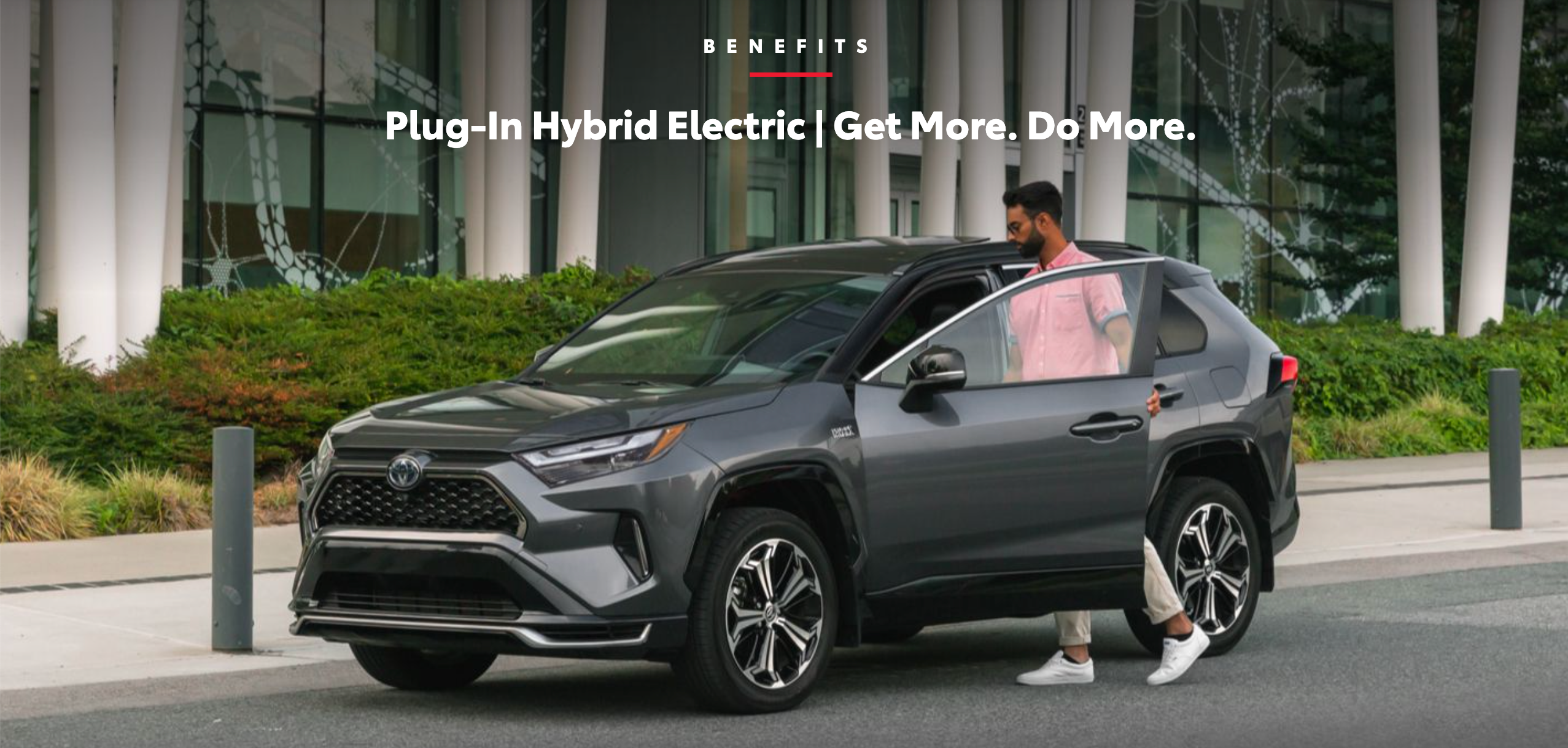Toyota Electrified
Hybrid electric • Plug-in hybrid electric • Battery electric
• Hydrogen fuel cell electric

One Company, Multiple Solutions
At Toyota, we believe that different mobility need requires different mobility solutions.
That's why we're investing in a range of electrified technologies.
Hybrid electric vehicle
HEVs effortlessly merge the strength of a gas engine with electric motors. And with the hybrid battery recharging as you drive, there's no hassle of ever needing to plug in.
Plug-in hybrid electric vehicle
PHEVs function similarly to HEVs but offer the additional option of being plugged in for an extended electric-only driving range.
Battery electric vehicle
BEVs are zero emission vehicles powered solely by electricity. They rely on plugging in for recharging and employ regenerative braking to replenish the onboard battery while in motion.
Hydrogen fuel cell electric
FCEVs use hydrogen as an energy source to power high-output electric motors, emitting water as the only by-product from the tailpipe.

Get in and go
Hybrid electric powertrains work automatically in the background, so you don't need to change a thing about how you drive or fuel your vehicle.
Go the distance
The hybrid battery recharges on the go so you have the added confidence to get you where you need to go, without the need to plug in.
Quick & quiet
The electric motors deliver Instant torque for instant acceleration and a soothingly quiet ride.
Help reduce fuel costs and emissions
Depending on your driving needs and habits, you can spend some of the time in zero-fuel, zero-emissions driving.
No additional routine maintenance
Toyota hybrid electric vehicles follow the same maintenance schedule as our gas-powered vehicles.
Part of the solution
Since 1997, electrified Toyota vehicles have prevented over 94 million tons of CO2 emissions globally.

Less fuel. Lower emissions
PHEVs can travel faster and further in EV-mode than conventional hybrid electric vehicles. So you can spend more time in zero-fuel driving, and reduce emissions even more.
Leave range anxiety behind
With both a gas engine and electric motor, even if your hybrid battery runs low, you never need to worry about finding a charging station.
Powerful response
The electric motor provides immediate torque for instant acceleration. Automatically switching between gas and electricity means you enhance performance under every driving condition.
EAWD for all-weather confidence
Toyota PHEVs are available with electronic-All-Wheel-Drive that features dedicated motors at every wheel for added confidence no matter what the conditions.
No additional maintenance
A Toyota PHEVs maintenance schedule is nearly identical to one of our gas powered vehicles.
Enjoy more incentives
PHEVs qualify for the federal government's iZEV program which offers an incentive for the purchase of a qualifying vehicle. Visit Transport Canada to learn more.

Quick, smooth & quiet
Instant torque means instant acceleration. With no transmission and no gears, the drive is exceptionally smooth. With electric motors, you'll also notice a world of quiet.
Electric-only range
Modern BEVs can travel further than you may realize. With more than 5,000 public charging stations across the country, it is easy to re-charge along the way.
Emissions-free driving
Reducing CO2 emissions by going fully electric is one way we can help lessen greenhouse gasses, and lessen our impact on the environment.
Save on fuel costs
Electricity is cheaper than gas. Savings can be even higher if you recharge during off-peak hours.
Lower maintenance costs
Say good-bye to oil changes. With no engine or transmission, BEV's have fewer mechanical parts. That could help add up to a lower cost of ownership, including service and maintenance costs.
Incentives
The federal government's iZEV program offers an incentive of up to $5,000 for the purchase of a zero emission vehicle. Visit Transport Canada to learn more.

Clean
When hydrogen is made using renewable energy, it is completely carbon-free. When used to power an FCEV, like Mirai, the only tailpipe emission is water vapour.
Efficient
Electricity is produced onboard, and supplied to the electric motor as needed. Excess energy is stored in a compact battery pack.
Familiar
There's no need to change your driving habits. Where refueling infrastructure exists, simply fill the hydrogen fuel tank and you are ready to enjoy zero emissions driving at its finest.

FAQs
How does a hybrid electric vehicle work?
A hybrid electric vehicle (HEV) seamlessly combines the power of a gas engine with the efficiency of electric motors. The battery is recharged while you drive so it's always ready to go without ever needing to be plugged in.
How does a plug-in hybrid electric vehicle work?
A plug-in hybrid electric vehicle (PHEV) seamlessly combines the power of a gas engine with the efficiency of electric motors. While the hybrid battery recharges on the go, to get the full benefit of a plug-in -- including increased electric-only driving range -- the vehicle needs to be recharged from the power grid.
How does a battery electric vehicle work?
A battery electric vehicle (BEV) is powered entirely by a battery and single or dual electric motors. Like all electric vehicles, BEVs can also recharge their batteries to a limited degree through regenerative braking. To achieve a full charge, BEVs need to be plugged in.
How does a hydrogen fuel cell electric vehicle work?
A hydrogen fuel-cell electric vehicle (FCEV) uses on-board fuel cells to generate electricity from hydrogen and oxygen that in turn is used to power an electric motor. An FCEV, like the Toyota Mirai, XLE only takes about five minutes refuel, emits only water from its exhaust, and has a range of up to 647 km on a full tank*.
Fueling time varies with hydrogen fueling pressure and ambient temperature.
* Range of up to 647km (2022 Mirai XLE) and up to 602km (2022 Mirai Limited) based on Government of Canada approved test methodology for fuel cell electric vehicles. Estimated FCEV range rating when hydrogen tanks are completely full. Actual mileage traveled will vary and is dependent on many factors such as traffic, road and weather conditions, vehicle maintenance, refueling practices, driving speed and style, fuel cell age, battery age, and cargo load.
Are Toyota electrified vehicles as safe as a conventionally powered vehicle?
Toyota's hybrid electric systems are designed and tested for Canada just like any Toyota vehicle, and adhere to Canada Motor Vehicle Safety Standards. HEVs, PHEVs and BEVs cause no greater concern for passengers or rescuers in the event of a collision than non-hybrid vehicles.
The batteries are sealed in a protective metal case and insulated from the vehicle body. Additionally, hybrid electric battery cables are shrouded in bright-orange cladding as a warning to emergency workers, and Toyota works closely with first responders to provide information and material for training on how to work with hybrid electrics.
Do Toyota electrified vehicles require additional maintenance?
Not only do Toyota hybrid electric vehicles follow the same maintenance schedule of every 6 months or 8,000 KM (whichever comes first), but the way the hybrid electric system works may reduce how often other areas of the car need servicing.
Depending upon how the vehicle is driven, in a hybrid electric, the engines are off some of the time, the brakes are regenerative, saving pad & rotor life, there is no transmission fluid under load, and there are no starters, alternators or belts to be replaced.
Do I need to change my driving or refueling habits with a Toyota electrified vehicle?
Drive a Toyota hybrid electric vehicle like you would any typical conventionally-powered vehicle. Toyota's Hybrid Synergy Drive system works seamlessly in the background, optimizing the combination of gas and electric power as you drive.
Fueling a Toyota hybrid electric vehicle is identical to fueling a conventional gasoline-powered vehicle; you do not need to plug it in. Plug-in hybrid electric vehicles offer the benefits of a hybrid electric, with the option to plug the vehicle in for extended electric-only range.
